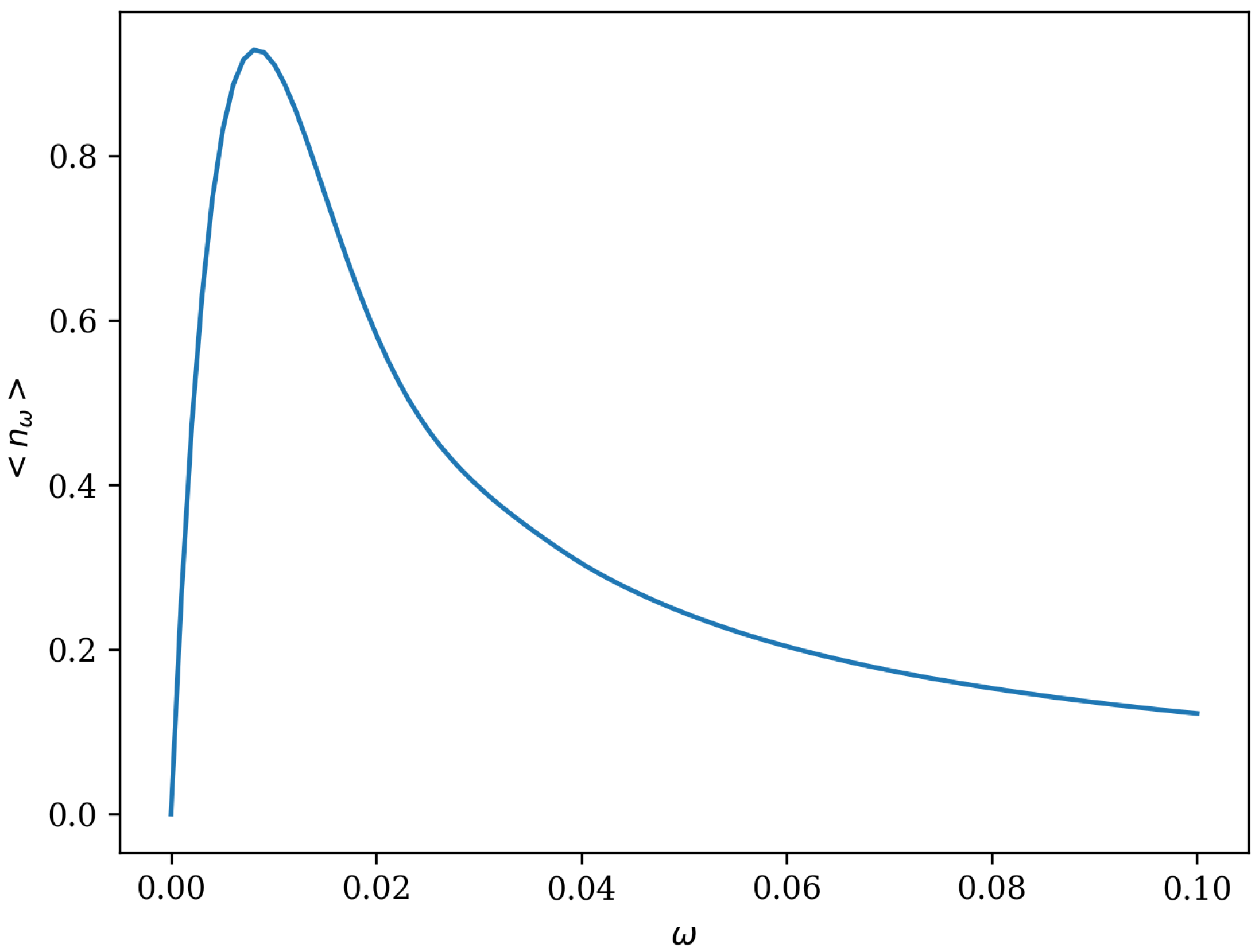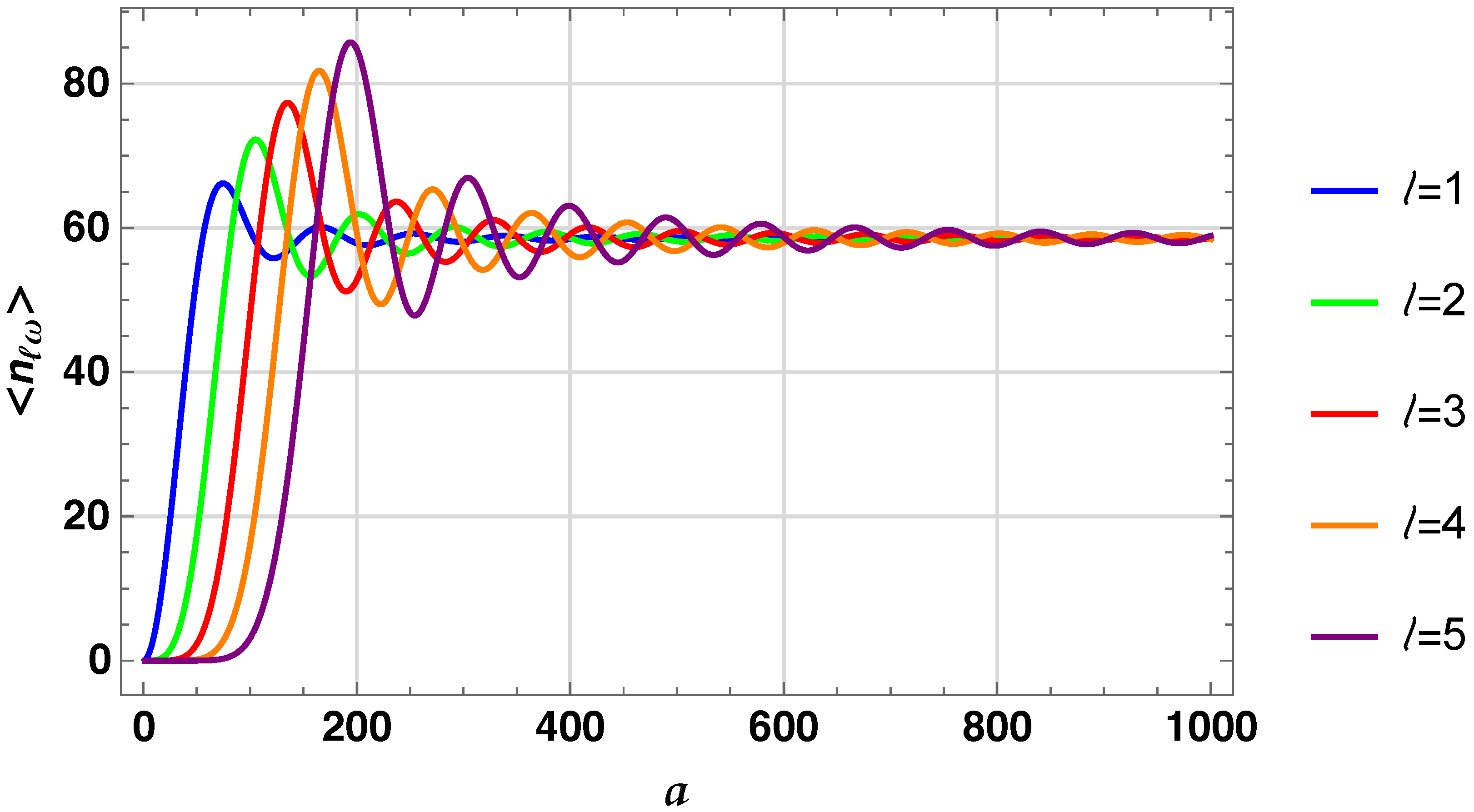Anisotropic Particle Creation from the T-Vacuum in the Radiation-Dominated Universe
Abstract
1. Introduction
2. Novel Geometric Features of the Radiation-Dominated Early Universe
2.1. Conformal vs. Spherically Symmetric Forms of the Radiation Stage
2.2. Identification of Cosmological Observers in the Frame
2.3. Cosmological Foliation in Frame
2.4. Hubble Parameter and Horizon Behavior in the Frame
2.5. The Relationship Between the Frame and the Static de Sitter Frame
3. Field Modes in Conformally Flat FRW
3.1. Field Modes for the s-Wave Approximation
3.2. Field Modes Beyond the s-Wave Approximation
4. Field Modes in Spherically Symmetric FRW
4.1. Sub-Hubble Region
4.1.1. Field Modes for the s-Wave Approximation
4.1.2. Field Modes Beyond the s-Wave Approximation
4.2. Super-Hubble Region
4.2.1. Field Modes for the s-Wave Approximation
4.2.2. Field Modes Beyond the s-Wave Approximation
5. Particle Creation from the T-Vacuum
5.1. Particle Number Density for the s-Wave Approximation
5.2. Particle Number Density Beyond the s-Wave Approximation
6. Discussions and Outlook
Author Contributions
Funding
Acknowledgments
Conflicts of Interest
| 1 |
Appendix A. The Normalization Constant for Cosmological Modes
Appendix B. Bogolyubov Coefficient for ℓ > 0
References
- Hawking, S.W. Black hole explosions? Nature 1974, 248, 30. [Google Scholar] [CrossRef]
- Hawking, S.W. Particle creation by black holes, Commun. Math. Phys. 1975, 43, 199. [Google Scholar] [CrossRef]
- Parker, L. Particle creation in expanding universes. Phys. Rev. Lett. 1968, 21, 562. [Google Scholar] [CrossRef]
- Parker, L. Quantized Fields and Particle Creation in Expanding Universes. I. Phys. Rev. 1969, 183, 1057. [Google Scholar] [CrossRef]
- Parker, L. Quantized Fields and Particle Creation in Expanding Universes. II. Phys. Rev. D 1971, 3, 346, Erratum in Phys. Rev. D 1971, 3, 2546. [Google Scholar] [CrossRef]
- Unruh, W.G. Notes on black-hole evaporation. Phys. Rev. D 1976, 14, 870. [Google Scholar] [CrossRef]
- Crispino, L.C.B.; Higuchi, A.; Matsas, G.E.A. The Unruh effect and its applications. Rev. Mod. Phys. 2008, 80, 787–838. [Google Scholar] [CrossRef]
- Steeg, G.V.; Menicucci, N.C. Entangling power of an expanding universe. Phys. Rev. D 2009, 79, 044027. [Google Scholar] [CrossRef]
- Martin-Martinez, E.; Menicucci, N.C. Cosmological quantum entanglement. Class. Quantum Grav. 2012, 29, 224003. [Google Scholar] [CrossRef]
- Foo, J.; Mann, R.B.; Zych, M. Entanglement amplification between superposed detectors in flat and curved spacetimes. Phys. Rev. D 2021, 103, 065013. [Google Scholar] [CrossRef]
- Conroy, A. Unruh–DeWitt detectors in cosmological spacetimes. Phys. Rev. D 2022, 105, 123513. [Google Scholar] [CrossRef]
- Fuentes, I.; Mann, R.B.; Martin-Martinez, E.; Moradi, S. Entanglement of Dirac fields in an expanding spacetime. Phys. Rev. D 2010, 82, 045030. [Google Scholar] [CrossRef]
- Wang, J.; Tian, Z.; Jing, J.; Fan, H. Parameter estimation for an expanding universe. Nucl. Phys. B 2015, 892, 390–399. [Google Scholar] [CrossRef]
- Moradi, S.; Pierini, R.; Mancini, S. Spin-particles entanglement in Robertson–Walker spacetime. Phys. Rev. D 2014, 89, 024022. [Google Scholar] [CrossRef]
- de Haro, J.; Pan, S. Gravitationally induced adiabatic particle production: From Big Bang to de Sitter. Class. Quantum Grav. 2016, 33, 165007. [Google Scholar] [CrossRef]
- del Río, A.; Navarro-Salas, J.; Torrenti, F. Renormalized stress-energy tensor for spin-1/2 fields in expanding universes. Phys. Rev. D. 2014, 90, 084017. [Google Scholar] [CrossRef]
- Landete, A.; Navarro-Salas, J.; Torrenti, F. Adiabatic regularization for spin-1/2 fields. Phys. Rev. D 2013, 88, 061501. [Google Scholar] [CrossRef]
- Kanno, S. Nonclassical primordial gravitational waves from the initial entangled state. Phys. Rev. D 2019, 100, 123536. [Google Scholar] [CrossRef]
- Grishchuk, L.P.; Sidorov, Y.V. Squeezed quantum states of relic gravitons and primordial density fluctuations. Phys. Rev. D 1990, 42, 3413–3421. [Google Scholar] [CrossRef]
- Kanno, S.; Soda, J. Detecting nonclassical primordial gravitational waves with Hanbury-Brown–Twiss interferometry. Phys. Rev. D 2019, 99, 084010. [Google Scholar] [CrossRef]
- Modak, S.K. Physical observers, T-vacuum and Unruh like effect in the radiation dominated early universe. J. High Energy Phys. 2020, 12, 31. [Google Scholar] [CrossRef]
- Modak, S.K. New geometric and field theoretic aspects of a radiation dominated universe. Phys. Rev. D 2018, 97, 105016. [Google Scholar] [CrossRef]
- Salazar, J.R.; Modak, S.K. Quantum field theory in a de-Sitter universe transiting to the radiation stage. J. High Energy Phys. 2022, 5, 48. [Google Scholar] [CrossRef]
- Singh, S.; Modak, S.K.; Padmanabhan, T. Evolution of quantum field, particle content and classicality in the three stage universe. Phys. Rev. D 2013, 88, 125020. [Google Scholar] [CrossRef]
- Modak, S.K. Cosmological Particle Creation Beyond de Sitter. Int. J. Mod. Phys. D 2019, 28, 1930015. [Google Scholar] [CrossRef]
- Astilla, D.S.; Modak, S.K.; Bhattacharya, S. IIT Bombay, Powai, India and CSPU, Pomona, USA. 2025. manuscript in preparation.
- Navarro-Salas, J.; Fabbri, A. Modeling Black Hole Evaporation; Imperial College Press: London, UK, 2005; ISBN 978-1-86094-527-4. [Google Scholar]
- Fulling, S.A.; Davies, P.C.W. Radiation from a moving mirror in two dimensional space-time: Conformal anomaly. Proc. R. Soc. Lond. 1976, A348, 393. [Google Scholar]
- Davies, P.C.W.; Fulling, S.A. Radiation from moving mirrors and from black holes. Proc. R. Soc. Lond. 1977, A356, 237. [Google Scholar]



Disclaimer/Publisher’s Note: The statements, opinions and data contained in all publications are solely those of the individual author(s) and contributor(s) and not of MDPI and/or the editor(s). MDPI and/or the editor(s) disclaim responsibility for any injury to people or property resulting from any ideas, methods, instructions or products referred to in the content. |
© 2025 by the authors. Licensee MDPI, Basel, Switzerland. This article is an open access article distributed under the terms and conditions of the Creative Commons Attribution (CC BY) license (https://creativecommons.org/licenses/by/4.0/).
Share and Cite
Astilla, D.S.; Modak, S.K.; Salazar, E. Anisotropic Particle Creation from the T-Vacuum in the Radiation-Dominated Universe. Universe 2025, 11, 318. https://doi.org/10.3390/universe11090318
Astilla DS, Modak SK, Salazar E. Anisotropic Particle Creation from the T-Vacuum in the Radiation-Dominated Universe. Universe. 2025; 11(9):318. https://doi.org/10.3390/universe11090318
Chicago/Turabian StyleAstilla, Dhamar S., Sujoy K. Modak, and Enrique Salazar. 2025. "Anisotropic Particle Creation from the T-Vacuum in the Radiation-Dominated Universe" Universe 11, no. 9: 318. https://doi.org/10.3390/universe11090318
APA StyleAstilla, D. S., Modak, S. K., & Salazar, E. (2025). Anisotropic Particle Creation from the T-Vacuum in the Radiation-Dominated Universe. Universe, 11(9), 318. https://doi.org/10.3390/universe11090318




